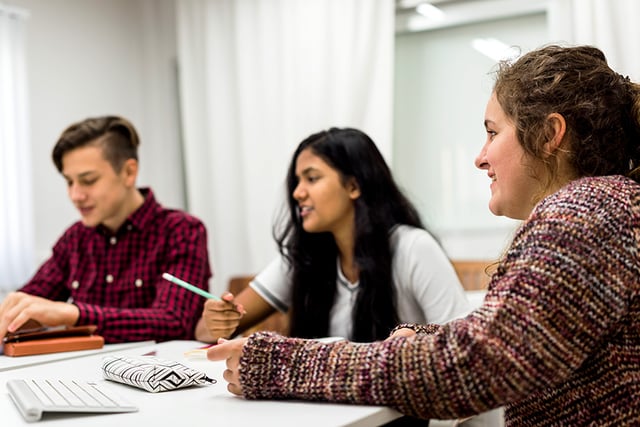Succeeding in Online Learning: Communication, Instruction, and Human Relationships
 Insights By Michael Cornell
Insights By Michael Cornell
When the COVID-19 pandemic swept throughout New York City, we became faced with a tremendous challenge that we needed to address in a timeframe like never before. Like many others, we faced incredible uncertainty, but united together to find the best path forward. We had no guiding manual or previous experience to rely on, but we all maintained our burning and passionate desire to support our students, families, and greater community in the best way possible. Adapted from an African proverb, we often say, “We are the village that raises the child.” I believe it is this community-based collaborative perspective grounded in the resolve to provide the best holistic, learning environment for our students that enabled us to have a successful experience closing out the school year in remote learning and preparing for the upcoming year.
Right from the beginning, we reached out to all our families in any and every way we could – email, text, phone, Class Dojo – with every bit of information we had. We kept open lines of communication and continued to share information each step of the way. We communicated amongst each other as a faculty through email and WhatsApp, with our families and students, and they with us. At times, communication was not always easy, as many of us experienced a significant learning curve with the technology and the new social dynamics from working at home with a family. However, we maintained an updated parent/guardian contact list and worked as a team to be able to engage each family. Through our continual outreach, we were able to deepen our relationships with our families. From the Spring until the end of the school year, these channels of communication became our lifelines and allowed us to provide the best support possible.
As communication structures were being established, we ensured that all students had the necessary technology to engage in online learning. Some of our students already had their own personal devices at home, however, many of our students were provided technology from the school and the district. Knowing that all students and families had different levels of proficiency with using technology for learning, the question at the forefront of my mind was, “How can I setup an online learning environment that is accessible for all students and families?” At the same time, I wanted to ensure this was a robust learning environment that provided a high-quality experience for my students. I wanted my students to feel safe and successful and I wanted to create an environment in which I could sustainably provide feedback and support students with their learning.
Fortunately, my 5th graders were already familiar with Google Classroom, as the 5th grade team had been using it throughout the year for homework and other resources. Even though online learning offered different dynamics than in-person learning, it was clear that it would be best to ensure opportunities for live instruction. Yet, I knew that teaching an entire class online would be ineffective and that many students would not be able to attend regularly due to the changes in family dynamics. As a result, the first course of action was to create a weekly small-group schedule for live instruction and communicate immediately to our student and families. While this was posted on Class Dojo and Google Classroom, as the 5th grade team, we found it most effective to communicate with our students through the chat feature on Google Hangouts. Since Google Classroom, Gmail, Drive, and Hangouts all operated within the G-Suite, we found it to be a very simple and efficient way to have an integrated platform for communication and learning. We encouraged our students to leave their Google Hangouts open on their laptop throughout the day and for those who had the Hangouts app on their phone, we could essentially “text message” them from our laptops. This made it simple and sustainable to be in direct communication with our students and provide them with necessary information and links for their learning – to the live video classes, supporting tools and resources, and discussion boards. Although it took some time to build this culture, by continuing to make outreach and deepening our relationships with our families, we were able to best support our student’s learning.
Returning to the question, “How can I setup an online learning environment that is accessible for all students and families?” I then needed to consider how instruction would be provided when students were not in their small groups. Again, considering the student experience and providing sustainable instruction, I decided to employ the use of asynchronous web-based instructional videos to deliver content and learning activities. For each week, I would post the instructional videos and corresponding assignments on Google Classroom, labeled by day and focus concept or skill. Each morning, I would post a message on the Stream to welcome students and provide reminders. I followed this process each day and week and within a short period of time, students were able to access and take responsibility for their work quickly and easily. These videos and assignments also had many built-in supports, including various tools, visuals, scaffolds, manipulatives, and question help. In this way, students were able to take ownership for their learning and proceed at a pace appropriate to them with all the supports they needed.
When I was not working with students in their scheduled small-group live instruction groups, I devoted the rest of my hours to supporting students with the concept and skills they were learning in the instructional videos. Students were able to message me on Google Hangouts if they needed help and we would be able to setup one-on-one video calls to review concepts and work through problems together. Through these various layers of support – small-group live instruction, web-based asynchronous instructional videos with corresponding activities, and one-on-one support – I was able to most effectively meet the needs of my students.
In addition, to help me plan my efforts strategically, I created a gradebook using Google Sheets. This gradebook allowed me to keep track of each student’s daily assignments and assess their current progress and understanding. It also helped me to keep track of the daily feedback I gave students based on their learning activities. Over time, this spreadsheet became a central aspect of how I made my decisions. I could easily tell which students needed more support, which students were missing work, and which students were improving. Based on that information, I knew which students to connect with to setup a meeting, which families I needed to get in touch with, and which students to develop a more supportive instructional plan for.
From this gradebook, I also built a reporting feature that took student’s weekly progress and generated a report that was sent to both the students and their families at the end of the week. This report helped the students stay accountable for their work and identify areas in which they needed to improve. If they were missing work, it was made clear to them before too much time had passed so that they could easily make it up and learn the material. The families also had a sense of how their child was doing each week and could make additional efforts to support their child at home and stay connected to the learning process. For many students, they were motivated to do better by seeing their progress and began to even ask for their reports before they were sent at the end of the week. It was this continuous flow of communication between teacher, students, and families along with the necessary instructional supports that made it possible to effectively support students during remote learning.
The greatest challenge was, and I think will continue to be, student engagement during remote learning. Of course we want our curriculum and instruction to be motivating and engaging, however, I found that the determining factor in student’s success, especially those that were struggling, is the human relationship between teacher and student and teacher and family. For both the student and family to know and feel that the teacher would do anything they could to support, while never giving up on the student, gave the student and family the strength and hope to continue persevering.
Moving into the uncertainty of the 2020-2021 school year this Fall, I am going to create more time to personally connect and deepen my relationships with all my students and their families. This past Spring (2020), I taught several 30 minutes small-group live instruction classes in the morning each day, focusing on scaffolding, differentiating, reinforcing, and thinking more deeply about the concepts and skills taught in the web-based, asynchronous instructional videos. Each day for five days a week, the students had one web-based, asynchronous instructional video and corresponding learning activity. When I was not working in the small groups, I was supporting students with their learning activities one-on-one or in partnerships.
If we continue to be fully remote, I will continue this structure but will limit the instructional videos and small-groups to four days a week, using the fifth day to allow students more necessary time to complete their work, support those who are struggling, and make additional outreach to families. If we are in a hybrid model, then I will use time in the building for small-groups and maintain the web-based, asynchronous instructional videos and learning activities as a daily expectation. Yet, with much still unknown, by maintaining effective communication and continuously deepening our relationships with families, we will be able to respond to any circumstance in the most supportive way.




